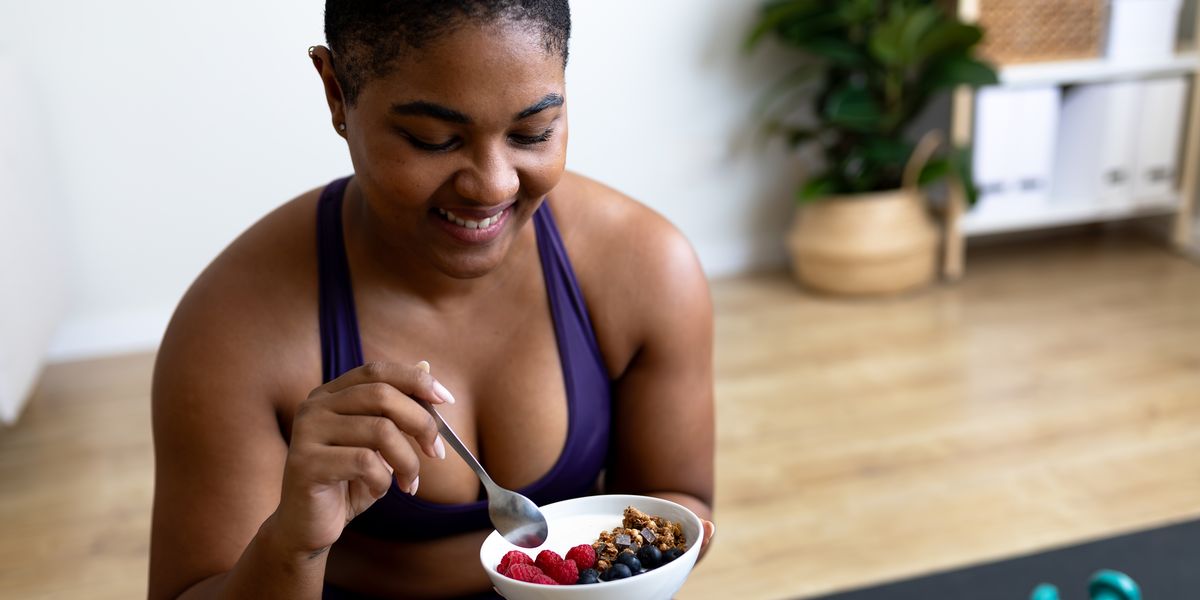Protein is a hot topic of conversation, especially when it comes to women as some experts say that they likely need to eat more protein than what they’re currently consuming.
When it comes to protein timing, the hour of the day during which you consume protein doesn’t matter, in and of itself, quite as much as how you distribute your intake throughout the day.
If you’re like most Americans, you’re probably getting the bulk of your protein at dinner. Women between the ages of 20 and 49 were found, on average, to consume about 42 percent of their daily protein at dinner and just 17 percent at breakfast, per a survey conducted by the U.S. Department of Agriculture’s (USDA) Agriculture Research Service.
What we should be aiming for instead is an equal distribution of protein throughout the day, say experts.
“Research shows spreading out protein intake every three to four hours or so into moderate doses versus a lot at once is associated with more optimal muscle repair and for those who are looking for growth, more optimal growth too,” says Jones.
Indeed, evenly spreading protein consumption among meals, rather than skewing it towards dinner “stimulated 24-hour muscle protein synthesis more effectively,” according to researchers at the University of Texas Medical Branch.
Why does it work better to spread out your protein all day?
The body benefits could be due to the way our body metabolizes protein and its building block, amino acids. Whereas surplus carbohydrates are stored in the body as glycogen and surplus fat as body fat, amino acids aren’t squirreled away as amino acids to be used later.
Rather, after our body has used what it can of the protein we eat at a meal—by supporting metabolism, producing hormones, maintaining bones and, yes, aiding muscle protein synthesis—it is then converted into either fat or glucose.
Research seems to indicate that around 20-25 grams of protein at one time is the upper limit that our body can use in muscle synthesis (though one study put the number closer to 30 grams). Essentially, anything in excess of 20-30 grams at a single meal may not make a huge difference as far as protein actions in the body go.
Another reason you may want to consider equal distribution throughout the day? You’ll probably just get less hangry.
“People notice that when they start to emphasize protein at breakfast and they ensure that it’s there at their snack too, they feel more satiated throughout the day,” Jones says. “They’re less likely to be distracted by hunger, they’re less likely to have blood sugar spikes and crashes.”
So do I need to eat protein right after a workout?
Perhaps you’ve heard the term anabolic or metabolic window (they’re often used interchangeably), which refers to the time period after a workout in which your muscles are repairing themselves and nutrition can play a role in aiding that process.
Depending on who you talk to, you may be told that time period is as brief as 15 minutes. Which would essentially mean you’d have to sip a protein shake while showering in order to get the timing just right.
Thankfully, research has led experts to widen this window considerably, to three or four hours (sometimes even five or six if you’re really pushing it). But the experts WH spoke with agreed that within two hours is optimal.
“Don’t go longer than two hours, and if you have big goals for gaining muscle and repairing muscle, get it closer to your workout, if you can,” says Jones.
As for the amount of protein, aim for 20-25 grams post-workout, recommends Tracy Anthony, PhD, a professor of nutritional sciences at Rutgers University in New Brunswick, New Jersey.
What about pre-sweat protein? Should I be eating that?
If all of this talk about post-workout fueling has you wondering about pre-workout fueling, we have that answer too. If you’re exercising for an hour or less, you probably don’t need to worry about protein intake ahead of time and can simply focus on getting high-quality protein after, says Jones.
Want more protein inspiration? Join WH+ to get the high-protein meal prep manual for breakfast, lunch, dinner, and snack recipes.
However, if you’re going for, say, a two-hour run or you tend to feel peckish if you don’t eat before exercising, grab a carb-rich snack with a few grams of protein first.
“It will help a little bit with your energy levels and reducing the amount of muscle damage you’re going to have go on there too,” Jones says.
Amy Wilkinson is a contributing entertainment editor at Women’s Health, where she edits the magazine’s celebrity cover stories and writes health features. She has previously held editor titles at Entertainment Weekly and MTV News. In 2021, Amy completed her 600-hour teacher-training at Core Pilates NYC to become a comprehensively trained Pilates instructor.
Read the full article here




